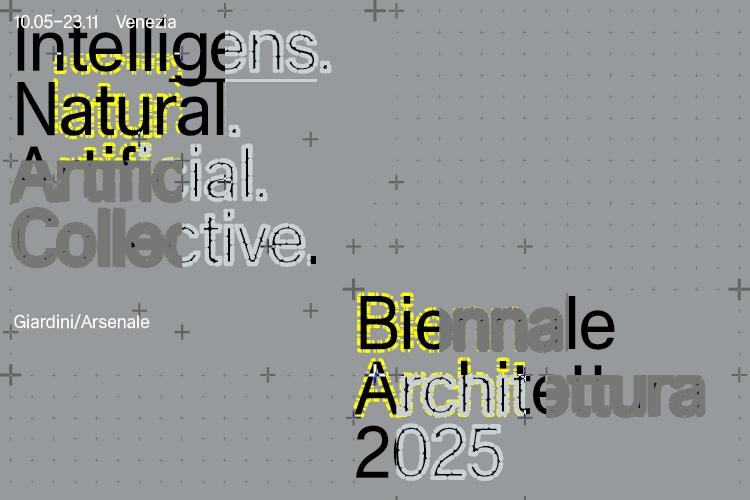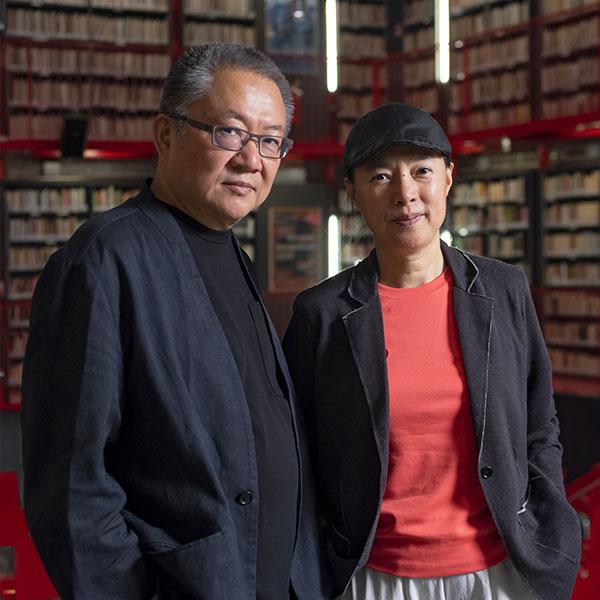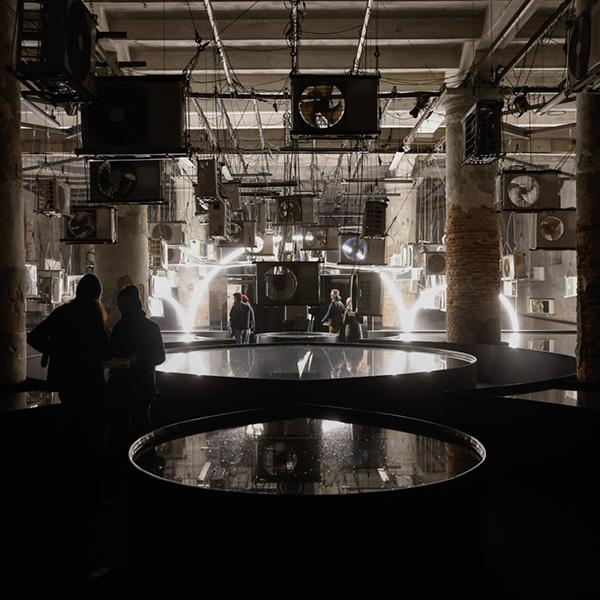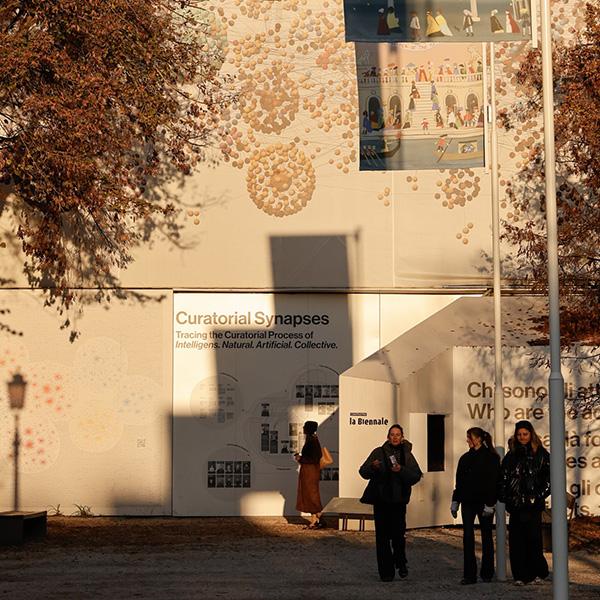
Biennale Architettura 2025: Intelligens. Natural. Artificial. Collective.
The 19th International Architecture Exhibition will be open from Saturday 10 May to Sunday 23 November.
Biennale Architettura 2025
The 19th International Architecture Exhibition, titled Intelligens. Natural. Artificial. Collective., curated by Carlo Ratti and organised by La Biennale di Venezia, is open to the public from Saturday May 10 to Sunday November 23,2025, at the Giardini, the Arsenale and at Forte Marghera. The awards ceremony and inauguration was held on Saturday May 10, 2025.
The International Exhibition of the Curator
«Architecture has always been a response to a hostile climate. From the earliest “primitive hut,” human design has not only been led by the need for shelter and survival, but also driven by optimism. Our creations have always strived to bridge the gaps between a harsh environment, the safe, liveable spaces we require, and the lives we want to live. Today, as the climate becomes less forgiving, that dynamic is being taken to a new level. Over the past two years, climate change has accelerated in ways that defy even the best scientific models. 2024 marked a grim milestone, as Earth registered its hottest temperatures on record, pushing global averages beyond the Paris Agreement’s 1.5°C target. And in the fires of Los Angeles, in the floods of Valencia and Sherpur, in the droughts of Sicily, we have witnessed the elements attacking us with unprecedented ferocity. When the knowledge and systems that have long guided our understanding begin to fail, new forms of thinking are needed. For decades, ever since we started counting carbon, architecture’s response to the climate crisis has been centred on mitigation—on reducing our impact on the climate. That approach is no longer enough. Architecture must pivot away from mitigation, reconnect with its longer history of adaptation, and rethink how we design for an altered world.»
«Adaptation demands a fundamental shift in architectural practice. This year’s Exhibition, Intelligens. Natural. Artificial. Collective., invites different types of intelligence to work together to rethink the built environment. The title, a neologism whose final syllable, “gens,” is Latin for “people,” is an invitation to experiment with intelligence beyond today’s limited focus on AI and digital technologies and demonstrate how we can adapt to the world of tomorrow with confidence and optimism. Intelligens serves as a dynamic laboratory, uniting experts across various forms of intelligence. For the first time, the Exhibition features over 300 contributions from more than 750 participants: architects and engineers, mathematicians and climate scientists, philosophers and artists, chefs and coders, writers and woodcarvers, farmers, and fashion designers, and many more. In times of adaptation, architecture is at the centre. In times of adaptation, architecture needs to draw on multiple forms of intelligence: natural, artificial, and collective. In times of adaptation, architecture needs to reach out across generations and across disciplines, from the hard sciences to the arts. In times of adaptation, architecture must rethink authorship and become more inclusive. Architecture must become as flexible and dynamic as the world we are now designing for.»
An Open Curatorial Framework
«We set out with a mission: to open up the curatorial process. Wherever travel took us, we invited the local community to join us—friends, colleagues, and a vast network spanning architecture and beyond— to gather around the table. The central curatorial exercise for Biennale Architettura 2025 was the Space for Ideas, an open call for proposals from people all around the world that evolved into the platform for feedback and iteration between the Curator and participants in the Exhibition. The massive response to this open forum presented a challenge in terms of sheer information processing. It also exposed a set of thinkers, practitioners, and new proposals that may have been impossible to unearth otherwise. This curatorial process has produced an Exhibition that is greater than the sum of its parts, and greater than it could have been through individual outreach alone. The Space for Ideas was an experiment, and an effort towards replicating the spontaneity that might be considered one of the signatures of intelligence across its many forms. The resulting participant pool spans generations—from seasoned professionals still innovating at ninety to recent graduates just beginning their careers. Pritzker Prize winners, former La Biennale di Venezia Curators, Nobel laureates, and Royal Professors appear alongside emerging architects and researchers. This richness of contributions calls for a new approach to authorship. Intelligens challenges the tradition of the architect as the sole creator, with other professionals relegated to supporting roles. The Exhibition demonstrates a more inclusive authorship model that is inspired by academic research. There, authorship is attributed to those who contribute significantly to the design, execution, and analysis of a project, regardless of their primary role. This collaborative approach ensures that every contributor’s intellectual input is acknowledged. Similarly, in times of adaptation, all voices driving design must be recognised.»
«The Biennale Architettura’s Circular Economy Manifesto, developed together with Arup and the Ellen MacArthur Foundation, sets bold goals for reducing waste and promoting material reuse. And most of the Exhibition itself is designed using recycled wood panels, which will be shredded at the end of the Exhibition and turned into new materials.»
The Exhibition
«The Exhibition begins in the Corderie with a stark confrontation: global temperatures rise while global populations fall. This is the reality architects must face in times of adaptation. From here, visitors traverse through three thematic worlds, which each in their own way put forward experiments in adaptation: Natural Intelligence, Artificial Intelligence, and Collective Intelligence. The Exhibition culminates in the Artiglierie with Out, which looks to space not as an escape, but as a way to help address the crises we face on Earth. Each section is conceived as a modular, fractal space: an organism that links large and small-scale projects, creating a web of dialogue and allowing visitors to find their own way through the Exhibition.»
«With the venue of the Central Pavilion under renovation in 2025, Venice will not just host the Biennale Architettura—it will become a Living Lab. The city itself—one of the most imperilled on Earth in the face of a changing climate—will serve as the backdrop for a new kind of Exhibition, where installations, prototypes, and experiments are scattered across the Giardini, the Arsenale, and other neighbourhoods. These Special Projects involve multidisciplinary teams comprising architects, scientists, and supporting companies, and offer innovative solutions and insights to pressing local and global issues. Running throughout the Exhibition are projects that form a Canon, which might hold valuable lessons for architects seeking to comprehensively address the theme of the Biennale Architettura today.»
«Inspired by Rem Koolhaas’s approach at the Biennale Architettura 2014, we sought to create thematic coherence among the National Participations under the framework One Place, One Solution. We invited each nation to explore architectural strategies grounded in their local context, yet ones that are relevant to global challenges.»
«Ultimately, the Biennale Architettura 2025 is more than an Exhibition; it’s a chain reaction, it is an experiment in uniting different voices and forms of intelligence. Some will resonate louder than others. Nonetheless, we hope that this choral effort will offer new insights into one of the defining challenges of our time: adapting to an altered world.»
GENS Public Programme
«In times of adaptation – explains Carlo Ratti – institutions such as La Biennale di Venezia are in a unique position to create collaborations with other leading institutions and bring its message to as wide of an audience as possible. Intelligens has forged connections with other global Institutions, the UN’s COP30 in Belem, C40, the Davos Baukultur Alliance, the Soft Power Club, and many others. Its public programme, GENS, will host a multitude of conferences, workshops, and other activations that engage audiences both large and small, local and remote.»
GENS will run throughout the six months of the Exhibition. The Conferences will take place starting May 10 in Sala delle Colonne at Ca’ Giustinian (La Biennale’s headquarters in San Marco) and in the Teatro Piccolo Arsenale, where scientists, artists, activists, students, politicians and practitioners all come together to showcase the breadth of human approaches to adaptation. The Workshops will run starting from the first pre-opening day, Thursday 8 May, at the Speakers’ Corner in theCorderie dell’Arsenale at the heart of the Exhibition, emphasizing interdisciplinary dialogue as a key theme of Intelligens. Along with the Conferences, the Workshops invite the public to engage with the ideas and materials of the Exhibition, mobilizing collective intelligence to transform the built and natural environments in response to the climate crisis, and expanding the meaning of Intelligens through public discourse.
The Speakers' Corner is designed by Christopher Hawthorne (Senior Critic, Yale School of Architecture), Johnston Marklee (Johnston Marklee & Associates) and Florencia Rodriguez (Director, University of Illinois Chicago School of Architecture), with the support of the Lincoln Institute of Land Policy. Complementing these events is Restaging Criticism, a series of meetings dedicated to contemporary architectural criticism, curated by Christopher Hawthorne and Florencia Rodriguez for the Speakers’ Corner, and structured around four categories: Modes and Platforms, Territories, Operative/Operation, Emerging Voices. The full programme will be continuously updated on labiennale.org.
Statement by the President of La Biennale
«Intelligently building the world, listening to the intelligence of the earth. This is Intelli/Gens, and it is what Carlo Ratti is building with his visionary Exhibition, its title already presenting itself as a founding reflection for the near future, a subject of study and debate for the scientific and artistic community and for the public that will visit it.»
«Carlo Ratti’s project and thought is indeed the future. His special vision transcends the contemporary—which is the time of divestment— to make architecture, our shelter since the dawn of time, a capacity to dwell in the world. In the dialectical arena of various disciplines, filled with algorithms that resemble prophecies, Ratti deciphers what we are and what we will become—as individuals and as a society—in the digital flow that shapes our future, the time of us, the Gens, endowed with Intelligence. And if intelligence is the foundation of the individual’s evolutionary process, in the noblest sense of being a civis (a third-declension noun, therefore both masculine and feminine), architecture is the space in which it can unfold, in a constant negotiation with the territory. Through functions, symbols and relationships, intelligence generates architectures guided by ethical, aesthetic and ecological principles. It is no coincidence that the Greek word oikos means both “house” to inhabit and “environment” to immerse oneself in.»
Golden Lions for Lifetime Achievement
The American philosopher Donna Haraway and the Italian architect and designer Italo Rota (2 October 1953 – 6 April 2024) have respectively been awarded the Golden Lion for Lifetime Achievement and the Special Golden Lion for Lifetime Achievement in Memoriam of the 19th International Architecture Exhibition – La Biennale di Venezia - Intelligens. Natural. Artificial. Collective. (Giardini and Arsenale, 10 May – 23 November 2025). The decision was approved by the Board of Directors of La Biennale chaired by Pietrangelo Buttafuoco, upon recommendation by Carlo Ratti.
International Jury
The International Jury of the 19th International Architecture Exhibition of La Biennale di Venezia is composed of Hans Ulrich Obrist (President), Swiss curator, critic, and art historian, Artistic Director of the Serpentine in London; Paola Antonelli, Italian curator, Senior Curator and Director of the Department of Architecture and Design at the Museum of Modern Art(MoMA) in New York; Mpho Matsipa, South African architect, lecturer, and curator. The composition of the Jury was approved by the Board of Directors of La Biennale di Venezia upon recommendation of Carlo Ratti.
College Architettura
Eight projects have been selected for the second edition of Biennale College Architettura 2024/25: Joelle Deeb (Syrian Arab Republic), Jia Wei Huang (Malaysia), Caterina Miralles Tagliabue (Spain), Agnes Thomasina Parker (Great Britain), Lucia Rebolino (Italy), Tanvi Khurmi (Canada), Rita Espinha Dos Santos Abreu Morais (Portugal), Florian Kilian Jaritz (Germany), Franziska Gödicke (Germany), Jaakko Julius Heikkilä (Finland), Emil Oscar Lyytikkä (Finland). The goal of the College Architettura 2025 is to complement the 19th International Architecture Exhibition with a research laboratory for the development and production of projects using natural, artificial and collective intelligence to fight the climate crisis. Over 200 students, graduates and emerging practitioners under the age of 30 from 49 countries around the world joined the call for participation. The eight projects will receive a grant of 20,000 euros for the realization of the final work. The works will be presented, out of competition, as part of the 19th International Architecture Exhibition of La Biennale di Venezia, Intelligens. Natural. Artificial. Collective., curated by Carlo Ratti.
National Participations
66 National Participations will organize their exhibitions in the historic Pavilions at the Giardini (26), at the Arsenale (25) and in the city centre of Venice (15). There are four new Participations: Republic of Azerbaijan, Sultanate of Oman, Qatar, Togo.
Italian Pavilion
The Italian Pavilion at the Tese delle Vergini in the Arsenale, sponsored and promoted by the Directorate-General for Contemporary Creativity of the Ministry of Culture, is curated by Guendalina Salimei with the project TERRÆ AQUÆ. L’Italia e l’intelligenza del mare. The exhibition is dedicated to the Mediterranean Sea extended to its neighbouring oceans. To look at Italy from the sea implies a change of perspective, imposes the need to rethink the design of the boundary between land and water as an integrated system of architecture, infrastructure and landscape.
Holy See
The Pavilion of the Holy See, promoted by the Prefect of the Dicastery for Culture and Education of the Holy See, Cardinal José Tolentino de Mendonça, will be hosted this year in the Complex of Santa Maria Ausiliatrice (Fondamenta S. Gioacchin, Castello 450). The title of the exhibit is Opera aperta, curated by Marina Otero Verzier and Giovanna Zabotti. The Pavilion will be a continuously evolving space that will host the collective work, alongside that of the architectural firms, of associations and living realities in Venice, invited to bring their skills and competencies to create a project open to the entire community, offering a vision of hope for the future of architecture, which enhances today’s world and those who live in it.
Venice Pavilion
The City of Venice participates in the historic Venice Pavilion at the Giardini, with an exhibition titled Libraries. Building Venetian Intelligence. The collective of curators, consisting of Benno Albrecht, Michele Casarin and Roberto Beraldo, has imagined the Pavilion as a great library, in which to build and develop collective intelligence, a driver for job creation. The city’s Pavilion will have further emanations in other institutional spaces and in the venues of the Università Iuav di Venezia.
Special Projects realised by La Biennale di Venezia
Margherissima is the Special Project of the 19th International Architecture Exhibition held inside the Polveriera Austriaca at Forte Marghera. The project proposes a vibrant new neighbourhood alongside the soaring silhouettes of heavy industry on the fringe of the Venetian lagoon: a walk-through model that transforms this vast industrial hinterland into a vibrant new district of the future, for citizens of a climate-conscious world. This collaborative project is realised by the students of the Architectural Association (School of Architecture, London), in collaboration with architect and curatorial lead Nigel Coates, with Michael Kevern, Guan Lee, John Maybury and Jan Bunge, who are participating in competition in the International Exhibition.
The Pavilion of the Applied Arts, presented for the ninth consecutive year by La Biennale di Venezia and the Victoria and Albert Museum in London, is titled On Storage. The exhibition explores the global architecture of the storage spaces used to move goods and presents a new six-channel film titled Boxed: The Mild Boredom of Order, directed by Diller Scofidio + Renfro (DS+R). The work was commissioned in view of the public opening of the V&A East Storehouse in London, a new operational warehouse and free admission visitor centre of the V&A designed by DS+R. Curated by Brendan Cormier, Chief Curator of V&A East, in collaboration with DS+R.
Special Project for the Biennale Architettura 2025
Intelligent Venice: la più antica città del futuro is the Special Project by the Fondazione Venezia Capitale Mondiale della Sostenibilità / Venice Sustainability Foundation (VSF) organized for the Biennale Architettura 2025 based on an agreement between La Biennale di Venezia and VSF. The exhibition focuses on a millennia-long project, a history shaped by medieval inventions and contemporary technologies, by interventions on nature and human settlement, by strategies for survival and resilience. For centuries they have guided Venice’s ability to survive a hostile environment, thanks to the continuous exercise of intelligence. Realised at the Tesa dell’Isolotto, Darsena Grande dell’Arsenale, curated by Benno Albrecht (Università Iuav di Venezia), Renato Brunetta (BSF and CNEL), Pierpaolo Campostrini (CORILA), Paolo Costa (C+3C Sistemi e Strategie).
Collateral Events
There are 11 Collateral Events scheduled for the 19th International Architecture Exhibition, approved by the Curator Carlo Ratti and promoted by non-profit national and international bodies and institutions. Held in various locations around the city of Venice, they offer a wide range of contributions and perspectives, enriching the diversity of voices that characterizes the exhibition in Venice.
Biennale Sessions, the project for Universities
This year as always, La Biennale di Venezia dedicates the Biennale Sessions project to Universities, Academies of Fine Arts, and other Institutes of Higher Learning. The project aims to provide them with special conditions to organize three-day visits for groups of 50 or more students and faculty members. It also offers logistical assistance in organising their stay in Venice, and the possibility of holding workshops free of charge in the educational spaces located within the exhibition venues. As of today, 28 Italian institutions have joined the project, along with 28 foreign institutions and 12 institutions involved in the programme through a joint project with DASTU Department/AUIC School - Politecnico di Milano, Bergische Universität Wuppertal, Bezalel Academy of Arts and Design, Leibniz University Hannover, Institute of Urban Design and Planning, POLI.design s.c.r.l. - Politecnico di Milano.
Educational: The Active Involvement of the Participants
La Biennale di Venezia’s Educational programme involves the entire array of educational proposals aimed at the audiences of its Exhibitions and Festivals, such as university students and faculty members, schools, families, art and architecture lovers and beyond. Over the past two years, Biennale Architettura 2023 and Biennale Arte 2024 have counted 131.509 participants in the Educational activities, including 72,125 young people. A wide-ranging Educational programme will be offered in 2025 as well, aimed at individuals and groups of students, children, adults, families, professionals, businesses, and universities. All these initiatives seek to actively involve the participants. They are led by professional operators, selected and trained by La Biennale, and are divided into the following categories: Guided Tours, Workshops and Interactive Initiatives. These tours combine a workshop experience with the visit, which may take place in the designated spaces or directly along the Exhibition route.
Editorial Project and Graphic Identity
The official catalogue, titled Intelligens. Natural. Artificial. Collective., consists of two volumes. Volume I of the catalogue is dedicated to the International Exhibition curated by Carlo Ratti, and is divided in two parts. Part one, titled Intelligens, is dedicated to presenting the sections of the Exhibition: Intro, Natural Intelligence, Artificial Intelligence, Collective Intelligence and Out. Each project on display in the Exhibition is accompanied by a critical text and a rich apparatus of photographs. Part two of the volume, titled Venice as a Living Lab, presents “a number of special projects that will leverage Venice and the outdoor areas of the Biennale Exhibition venues as a Living Lab – living laboratories, merging interacting forms of intelligence”. The volume is enriched with a series of critical essays and “Impossible Conversations” that explore the themes of the Exhibition in depth. Volume II presents the National Participations and the Collateral Events: it includes a series of illustrated texts that explore the projects proposed by National Pavilions and the Collateral Events at the Giardini, the Arsenale and in various spaces throughout Venice.
The graphic identity of the Biennale Architettura 2025 and the design of the publications are by Bänziger Hug Kasper Florio.The volumes are published by Edizioni La Biennale di Venezia.
La Biennale di Venezia's Commitment to Climate Action
Since 2021, La Biennale di Venezia launched a plan to reconsider all of its activities in light of recognized and consolidated principles of environmental sustainability. In 2022 La Biennale obtained the carbon neutrality certification for all the events it held that year. This was made possible by carefully collecting the data on the causes of the CO2 emissions generated by the events themselves, and on the adoption of consequent measures. The entire process for achieving, was conducted in compliance with the international standard PAS2060.
For the year 2025, the goal is to achieve the “carbon neutrality” certification in compliance with the new ISO 14068 standard, for all of La Biennale’s scheduled activities: the 82nd Venice International Film Festival, the Theatre, Music and Dance Festivals and, in particular, the 19th International Architecture Exhibition. For all the events, the most important component of the overall carbon footprint involves the mobility of the visitors. For this purpose, La Biennale will again in 2025 engage in a communication campaign to raise the awareness of the participating public.
A Circular Economy Manifesto launched by Carlo Ratti, with guidance from Arup and input from the Ellen MacArthur Foundation, strengthens La Biennale's commitment to this goal, promoting an increasingly sustainable model for the design, installation and operation of all its activities and events. The challenge is to create pavilions and spaces that are examples of a bold circular thinking that offer a lasting sustainability legacy. The goal is to eliminate waste, circulate materials and regenerate natural systems proving that architecture and our built environment can coexist harmoniously with our planet.
Partners and Sponsors
Biennale Architettura 2025 has been made possible by the support of Rolex, Partner and Official Timepiece of the event.
We would like to thank the Sponsors of Biennale Architettura 2025: Bloomberg Philanthropies, Vela - Venezia Unica, Hydro and Gruppo Saviola.
We would also like to thank Cleary Gottlieb Steen & Hamilton LLP.
Rai is the Media Partner of the 19th International Architecture Exhibition and will follow the event with a dedicated offer on TV, radio and on the web.
Bloomberg Connects is the official app of the Biennale Architettura 2025.
Acknowledgements
We would like to thank the Ministry of Culture, the local institutions that support La Biennale in various ways, the City of Venice, the Regione Veneto, the Soprintendenza Archeologia, Belle Arti e Paesaggio per il Comune di Venezia e Laguna, the Italian Navy and the Museo Storico Navale di Venezia.
We thank the important international Donors, organisations and institutions who are essential to the creation of the 19th Exhibition.
We especially wish to thank Carlo Ratti and his entire team.
Finally, we would also like thank the highly professional staff of La Biennale, who work with such great dedication on theorganisation and management of the Exhibition.




